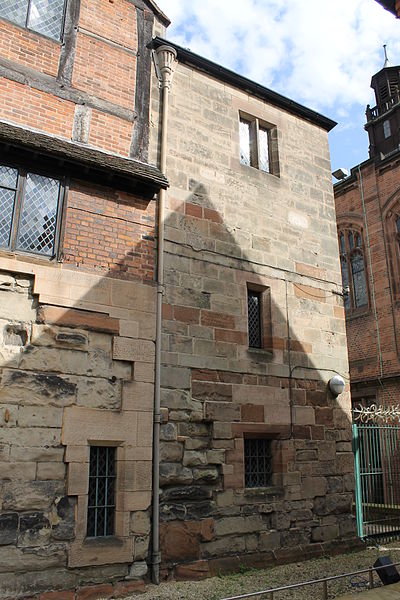Caesar’s Tower at St Mary’s Guildhall is the site of the Treasury and the Tower Room, and is a curious addition to the side of the Guildhall. Despite being part of St Mary’s Guildhall, Caesar’s Tower is commonly perceived by the general public as a representative of another historical edifice – Coventry Castle. The Wikipedia article dedicated to the castle is illustrated with a photograph of this tower, captioned as ‘all that remains of the castle’. [1] In numerous books and on the Internet, you can find references stating that Caesar’s Tower is a part of Coventry Castle, which was constructed in the 12th century. [2] Does this mean that Caesar’s Tower is the oldest part of St Mary’s Guildhall, which has been standing for over 850 years? Let’s try to figure it out.
The location where St Mary’s Guildhall was built in 1340-1342 occupied part of the territory of the Norman castle of the Earls of Chester, which was built approximately two hundred years earlier and lasted for about a century. In this area, a stretch of the castle ditch (which followed the line of Bayley Lane) has been discovered, and its western boundary adjoined the castle bakehouse. [3] The incorporation of the wall of Caesar’s Tower into the Prince’s Chamber strongly suggests that the tower was already in existence to this level at the time of construction of this part of the Guildhall (which started in 1392). [4]

(Image sourced from Wikimedia Commons)
The name ‘Caesar’s Tower’ is one normally attributed to castle towers. [5] Nearby castles such as Kenilworth and Warwick also have towers with similar names. [6] Therefore, it seems quite plausible that Coventry Castle could have had a tower with such a name.
In 1900, excavations were carried out at the foundation of the tower, which was dated to the mid-12th century. The dating was based on the discovery of the marks of an adze on the stones, a tool commonly used by Norman masons. [7] The base stones were squared by a tool similar to an adze and incorporated a narrow plinth about a foot high. [8]
It would seem that there is sufficient evidence of the venerable age of Caesar’s Tower. However, modern researchers have put forward counterarguments based on the analysis of documentary sources. It is strange, for example, that the name ‘Caesar’s Tower’ is first recorded only in the 17th century. Scholars speculate that the word ‘Caesar’ is possibly a corruption or misreading of ‘treasury’ (tresoria), as the middle storey of the tower did indeed house the treasury in the 15th century. [9]
It is also important to note that despite the presence of numerous earlier deeds, Caesar’s Tower is not mentioned in any of them and there is no documentary evidence of a tower in this location before 1393. [10] Therefore, it is more likely that it was built as part of the Guildhall either in 1340-1342 or at the very beginning of the second stage of construction in 1392. [11]
Nevertheless, some modern researchers continue to consider the version that Caesar’s Tower was a relic of the castle’s fortifications as a possibility. [12] Unfortunately, establishing the truth is difficult. The tower was demolished during the bombings of World War II, and the evidence was lost. [13] From 1946 to 1949, the tower was rebuilt as part of the reconstruction undertaken by the City Engineer’s Department utilising the services of a mason who worked from photographs. [14] The appearance of the Treasury room today can be seen in the header image of this blog.
Therefore, it is a relatively new reconstructed part of the Guildhall, which does not have a lifespan of a hundred years. However, it was created using stone from ancient structures, including the City Walls, [15] and it masterfully recreates the appearance of the original tower.
Header image taken by Volunteer Photographer Lucy Swain.
Sources
Coventry Medieval Art, Architecture and Archaeology in the City and its Vicinity, The British Archaeological Association, 2011.
Joan C. Lancaster, St Mary’s Hall, Coventry: A Guide to the Building, its History and Contents, 1948.
Raymond G. Holl, The History of St Mary’s Hall, Coventry, 1989.
Frederick Smith, Coventry: Six Hundred Years of Municipal Life, 1945.
David McGrory, A history of Coventry, 2003.
Footnotes
[1] https://en.wikipedia.org/wiki/Coventry_Castle
[2] http://news.bbc.co.uk/local/coventry/hi/people_and_places/history/newsid_8304000/8304486.stm
[3] Joan C. Lancaster, St Mary’s Hall, Coventry: A Guide to the Building, its History and Contents, 1948, page 4.
[4] George Demidowicz, ‘The Development of St Mary’s Hall, Coventry: A Shot History’, in: Coventry Medieval Art, Architecture and Archaeology in the City and its Vicinity, 2011, page 173.
[5] David McGrory, A history of Coventry, 2003, page 35.
[6] https://www.bl.uk/picturing-places/articles/literature-and-the-transformation-of-topography-the-case-of-kenilworth-castle-1700-1850 and https://www.warwick-castle.com/explore/things-to-do/attractions/towers-ramparts/
[7] David McGrory, A history of Coventry, 2003, page 35.
[8] Raymond G. Holl, The History of St Mary’s Hall, Coventry, 1989, page 5.
[9] George Demidowicz, ‘The Development of St Mary’s Hall, Coventry: A Shot History’ in: Coventry Medieval Art, Architecture and Archaeology in the City and its Vicinity, 2011, page 176.
[10] Ibid.
[11] Ibid.
[12] Iain Soden, ‘An Introduction to the Archaeology of Medieval Coventry’ in: Coventry Medieval Art, Architecture and Archaeology in the City and its Vicinity, 2011, page 10.
[13] Frederick Smith, Coventry: Six Hundred Years of Municipal Life, 1945, page 87.
[14] Raymond G. Holl, The History of St Mary’s Hall, Coventry, 1989, page 5.
[15] Ibid.

